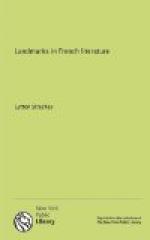—Aucassin, at once brave and naif, sensuous and spiritual, is as much the type of the perfect medieval lover as Romeo, with his ardour and his vitality, is of the Renaissance one. But the poem—for in spite of the prose passages, the little work is in effect simply a poem—is not all sentiment and dreams. With admirable art the author has interspersed here and there contrasting episodes of realism or of absurdity; he has woven into his story a succession of vivid dialogues, and by means of an acute sense of observation he has succeeded in keeping his airy fantasy in touch with actual things. The description of Nicolette, escaping from her prison, and stepping out over the grass in her naked feet, with the daisies, as she treads on them, showing black against her whiteness, is a wonderful example of his power of combining imagination with detail, beauty with truth. Together with the Chanson de Roland—though in such an infinitely different style—Aucassin et Nicolete represents the most valuable elements in the French poetry of this early age.
With the thirteenth century a new development began, and one of the highest importance—the development of Prose. La Conquete de Constantinople, by VILLEHARDOUIN, written at the beginning of the century, is the earliest example of those historical memoirs which were afterwards to become so abundant in French literature; and it is written, not in the poetical prose of Aucassin et Nicolete, but in the simple, plain style of straightforward narrative. The book cannot be ranked among the masterpieces; but it has the charm of sincerity and that kind of pleasant flavour which belong to innocent antiquity. The good old Villehardouin has something of the engaging naivete, something of the romantic curiosity, of Herodotus. And in spite of the sobriety and dryness of his writing he can, at moments, bring a sense of colour and movement into his words. His description of the great fleet of the crusaders, starting from Corfu, has this fine sentence: ’Et le jour fut clair et beau: et le vent doux et bon. Et ils laisserent aller les voiles au vent.’ His account of the spectacle of Constantinople, when it appeared for the first time to the astonished eyes of the Christian nobles, is well known: ’Ils ne pouvaient croire que si riche ville put etre au monde, quand ils virent ces hauts murs et ces riches tours dont elle etait close tout autour a la ronde, et ces riches palais et ces hautes eglises.... Et sachez qu’il n’y eut si hardi a qui la chair ne fremit; et ce ne fut une merveille; car jamais si grande affaire ne fut entreprise de nulles gens, depuis que le monde fut cree.’ Who does not feel at such words as these, across the ages, the thrill of the old adventure!




